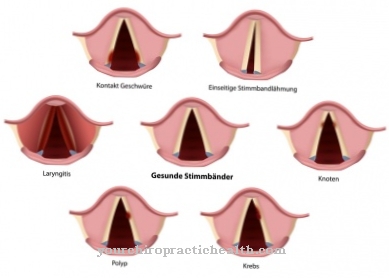At Galactorrhea - the abnormal breast milk discharge - it is a disease of the breast gland in which there is a secretion of milky secretions from the breast gland. The disease can occur on one or both sides and is often different in severity. Although galactorrhea is actually a painless disease, the chest can tense, which patients may find painful.
What is galactorrhea?
.jpg)
© matoommi - stock.adobe.com
Galactorrhea, the pathological discharge of breast milk, is a disease of the mammary gland in which milk secretion escapes from the nipple (nipple). Milk leakage is normal during pregnancy and breastfeeding, which is why galactorrhea is only viewed as a disease outside of these times.
In the case of galactorrhea, the milky secretion can escape either with light pressure or even spontaneously. In contrast to a pathological secretion of the mammary gland (secretion of other secretions), galactorrhea is only a form of pathological fluid secretion, in which milk escapes.
The disease is mostly due to hormonal disorders and fluctuations in the hormone balance and therefore does not really have a separate clinical picture. The hormone prolactin, which is produced by the pituitary gland, plays an important role in the development of the disease.
causes
The causes of galactorrhea are very different. The disease usually arises from an overproduction of the hormone prolactin. This hormone promotes milk production, which naturally promotes galactorrhea.
The main cause of galactorrhea are therefore hormonal disorders, but other causes are also conceivable. For example, the pituitary gland, which is responsible for the formation of prolactin, can also contain a prolactinoma - i.e. a tumor that produces prolactin. In most cases, such a tumor is benign.
Mastitis (inflammation of the mammary gland), a benign breast tumor (milk duct papilloma) or an early stage of breast cancer can also be causes of galactorrhea.Another cause of a physical nature is galactorrhea as a result of an underactive thyroid.
Non-physical causes of galactorrhea are often medications such as blood pressure medication, psychotropic drugs or gastrointestinal drugs, as well as birth control pills. Drugs like heroin and other opiates can also lead to this disease.
Non-pathological causes that can also cause galactorrhea include stimulation of the nipple, stress and physical exertion or even sexual intercourse.
Symptoms, ailments & signs
Galactorrhea is seen as milky or clear secretions from the nipple. The secretions are mostly white to amber and relatively odorless. The milk can come out on one side or from both breasts. Usually a few drops to a few milliliters of milk are excreted per day. Galactorrhea usually causes no further symptoms.
However, some patients experience menstrual cramps such as late or early menstrual periods, severe menstrual pain or cramps in the abdomen. Occasionally, the abnormal breast milk discharge is accompanied by a feeling of tension in the breasts. Galactorrhea is divided into three grades.
Grade 1 is associated with a small discharge of a few drops and mild menstrual pain. Second-degree galactorrhea usually means a noticeable discharge, often accompanied by a feeling of tension in the breasts and persistent menstrual cramps. In the third degree, there is a spontaneous secretion and various accompanying symptoms such as a feeling of illness or even fever.
Irrespective of the degree of discharge, inflammation in the nipple area, tension pain and overheating of the breasts can occur. The symptoms subside on their own after a few days to weeks and usually do not require medical treatment.
Diagnosis & course
Galactorrhea can usually only be diagnosed by a doctor. He will first inquire about the exact complaints and draw up an anamnesis. For a reliable diagnosis, the color and consistency of the secretion are important, the menstrual cycle and possible medication are also important for an accurate diagnosis.
When scanning the breast, palpable changes in the breast tissue can often be felt. To confirm the diagnosis of galactorrhea, a blood test is usually carried out to determine the concentration of the hormones prolactin, progestin, and estrogen. The thyroid values also play a role in the diagnosis. Ultrasound is also used for diagnosis. Mammography is also useful.
Before this, a so-called galactography is carried out, in which a contrast agent is injected into the milk duct with a thin tube. With the mammography, the doctor can then see whether the milk ducts are closed or dilated. If a tumor is suspected, the doctor will order either an MRI or a CT scan.
As a rule, the course of galactorrhea is benign, which is why the prognoses are quite positive. Often the symptoms can be treated well and disappear after therapy. Milk secretion can usually be stopped with medication. If the cause of galactorrhea is breast cancer, the further course always depends on the cancer stage and its therapy.
Complications
Galactorrhea is caused by an excess of the hormone prolactin. A common reason for this phenomenon is the use of certain psychotropic drugs that cause hormonal changes in the body (for example certain neuroleptics). Diseased breast milk discharge is associated with numerous complications. The breast enlarges unnaturally, and those affected often have tension pain in the chest. So it's not just an aesthetic problem.
Too much of the hormone prolactin can also cause menstrual disorders: This means that the natural menstrual period only occurs irregularly or does not occur at all. In the long run this can lead to osteoporosis in middle or mature years. In addition, a possible desire to have children often remains unfulfilled, as the ovaries and uterus "sleep", so to speak.
An excess of the hormone prolactin leads the body to believe that it is a permanent pregnancy, so that there is no more jumping in. In addition, if galactorrhea is not treated, the chances of developing cancers such as breast cancer and uterine cancer are increased. Those affected should seek treatment for the hormone imbalances in the body because of the potentially drastic consequences.
There are certain drugs on the market that can regulate the prolactin level. If these attempts fail, additional hormones must be released, which in turn are not free of risks such as an increased risk of cancer. Ideally, the drugs that cause abnormal breast milk discharge can be stopped or replaced with others that do not have these side effects.
When should you go to the doctor?
Women who have breast secretions leaking without being pregnant and who have recently given birth should see a doctor. The production of breast milk outside of a gestation is considered unusual and should be examined by a doctor. If you experience tension in the chest that is unrelated to the early onset or presence of menstrual bleeding or pregnancy, a doctor should be consulted.
A visit to a doctor is advisable in the case of hormonal disorders, mood swings and changes in libido. If there is a persistent whiny mood, aggressive behavioral tendencies or melancholy phases for no comprehensible reasons, a doctor should be consulted. Irregularities in the female cycle, extreme stress and changes in living conditions can trigger galactorrhea. Medical help should be sought as soon as medical assistance is required to cope with the incident.
If breast milk comes out repeatedly or sporadically or if the amount of fluid increases, the symptoms should be clarified by a doctor. A doctor should be consulted in the event of chest pain, general malaise, internal restlessness or malaise. If the woman suffers from the aesthetic problem, or if feelings of shame develop or emotional problems set in, it is advisable to discuss the symptoms with a doctor.
Doctors & therapists in your area
Treatment & Therapy
The therapy of galactorrhea depends heavily on the cause of the disease. In the case of hormone disorders and fluctuations, the doctor will probably seek medication with bromocriptine. This active ingredient inhibits the effects of the hormone prolactin.
This preparation is also often used for a prolactinoma. The removal of the prolactin is only necessary if the treatment with medication is unsuccessful - this is only very rarely the case, however.
If galactorrhea is only an accompanying symptom to another disease, the underlying disease must first be treated in a targeted manner. If the galactorrhea developed as a result of a breast infection, it makes sense to prescribe anti-inflammatory drugs or antibiotics.
In the case of galactorrhea caused by taking medication, it can be assumed that it will disappear again when the corresponding medication is discontinued. However, if you suspect that you should stop taking medication, you should only consult a doctor. In an emergency, there are also alternatives to the previous preparation.
Outlook & forecast
The prognosis of galactorrhea depends on the cause. If milk leakage occurs in women during the lactation phase, it is considered natural and is not considered a disease or disorder. With the process of weaning, there is usually an automatic regression of the symptoms until a full recovery takes place.
In the case of a hormone disorder, relief of the symptoms is rarely documented without treatment. Symptoms remain constant over time or increase in intensity and scope. The hormonal balance should be treated with medication so that the patient's health improves. Most patients experience healing with optimal therapy.
In addition, a chronic course of the disease is also possible. As soon as treatment is interrupted, the symptoms can be expected to relapse. Patients identified as being caused by an inflammatory process have a good chance of recovery. As soon as the pathogens have been killed and transported out of the organism, the symptoms regress. The healthier the body's defense system, the faster the healing process.
In the case of stress-related galactorrhea, a change in lifestyle is essential for healing. As soon as the emotional and mental burdens are relieved, the symptoms ease.
prevention
Galactorrhea cannot be effectively prevented. General measures for prevention are not known, as the abnormal breast milk discharge can be traced back to the most varied of causes.
Aftercare
In most cases, the options or measures for follow-up care for galactorrhea are very limited. The person concerned is primarily dependent on a quick and, above all, early diagnosis so that further complications and complaints do not occur. Only through early detection of this complaint can further restrictions on the quality of life be avoided.
Therefore the early diagnosis of galactorrhea is paramount. The treatment itself is usually carried out by taking medication, although self-healing cannot occur. Since in most cases antibiotics are also taken, those affected should ensure that they are taken regularly and that the dosage is correct.
The antibiotics usually have to be taken even after the symptoms have subsided. They should also not be taken together with alcohol, otherwise their effect will be weakened. In galactorrhea, the nipples should also be checked regularly for inflammation in order to detect and treat such early.
If the symptoms have subsided, no further aftercare is necessary. The life expectancy of the patient is also not negatively affected by this disease.
You can do that yourself
With galactorrhea, patients should ensure that they wear protective clothing to avoid unpleasant situations in everyday life. This is to be chosen in such a way that a milk discharge cannot be seen by the people in the vicinity and consequently soaking is avoided. The use of nursing pads, which can be purchased in drugstores, is suitable.
Since the disease creates a feeling of tension in the chest, wearing very tight clothing should be avoided. This increases the internal pressure and tension even further. With loose-fitting clothing, the patient often has the feeling of being able to breathe more easily and feeling more comfortable.
Conversations with relatives, doctors and other sick people help to reduce worries and fears. There are various digital contact points on the Internet where those affected can exchange ideas and help each other to cope with the complaints in everyday life.
The tips described there can be tried out independently and strengthen the patient's well-being. In addition, relaxation methods have proven themselves to reduce stress in everyday life. Using techniques such as yoga or meditation, those affected can carry out exercises independently and according to their individual preferences in order to build up their mental strength.



.jpg)

.jpg)


















.jpg)



